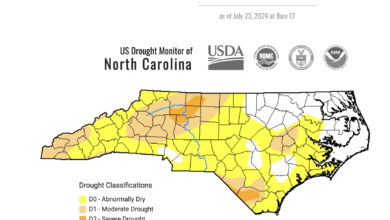Last Updated on February 12, 2022 6:35 pm
Today, just in time for Memorial Day, the U.S. Forest Service Southern Research Station (SRS) unveiled the Forest Trail Explorer, a searchable web application (web app) that combines details on three popular trail systems in western North Carolina with the state-of-the-science information the SRS Forest Inventory and Analysis (FIA) unit collects on the region's forests.
SRS, the Forest Service National Forests in North Carolina (NFNC) and the University of North Carolina Asheville National Environmental Modeling Analysis Center (NEMAC) collaborated on the project. The new web app can be found at www.nctrails.org.
“The Forest Trail Explorer illustrates how Forest Service research, the national forest system, and partners can collaborate to create innovative products for today's outdoor enthusiasts,” said SRS director Rob Doudrick. “This site uses today's technology to benefit visitors and communities, and it could serve as a model for other national forests interested in using FIA data to inform and enhance the user's outdoor experience.”
The Browse Trails section of the web app provides details on trails in the Tsali (pronounced “SAH-lee”) Recreation Area, located in the Nantahala National Forest Cheoah Ranger District, and the Jackrabbit Recreation Area in the national forest's Tusquitee Ranger District. The site also features two large sections of the Appalachian Trail that pass through the Nantahala National Forest.
Hikers, mountain bikers, horseback riders and others will find trail information they need to have a safe and enjoyable trip, including trail type, length, difficulty, elevation, and fly-overs of some trails. In addition, users can download files of the trails and view them on their computers or tablets using Google Earth. The files allow users to see the trails and terrain in a detailed interactive format. Users can easily view the Forest Trail Explorer with a smartphone or other mobile device.
“I commend the Southern Research Station for their leadership in developing this product, which has the potential to promote tourism in western North Carolina and benefit local economies,” said Kristin Bail, NFNC forest supervisor. “At the same time, the site informs visitors about the forest issues and health in the region.”
Users can learn about nature and the environment surrounding the national forest trails in western North Carolina. The Forest Trail Explorer uses FIA information to provide information on topics ranging from ecosystem and threats to forest products, recreation to weather and climate.
Information included in the Learn About Nature section is based on a regional assessment called the Western North Carolina Vitality Index (www.wncvitalityindex.org), which uses metrics to report on the unique aspects of the region's natural and socioeconomic environment. The report analyzes forest characteristics on private land as well as public land.
Additionally, the Forest Trails Explorer offers safety tips and connects visitors to safety alerts issued by NFNC. The site also includes camping information. The Forest Service hopes to expand Forest Trail Explorer in the coming years.
“Our goal is to enhance the Forest Trail Explorer by adding more trails and more science-based information in the future,” said Doudrick. “By collaborating with partners, we'll accomplish more than we can do individually.”
The Forest Service designed Forest Trail Explorer for planning purposes only. Forest visitors should always carry a map and compass when in a national forest.
For more information, read the Forest Trail Explorer flyer at: http://www.fs.usda.gov/Internet/FSE_DOCUMENTS/stelprd3801189.pdf














